The year 1967 was a major turning point in the history of the Korean Orders of Merit. For example, the original Order of Service Merit does not have the same focus as the current Order of Service Merit. The same can be said of the Order of Civil Merit and the Order of Cultural Merit. Here are a few quick points to consider when looking at Korean Orders.
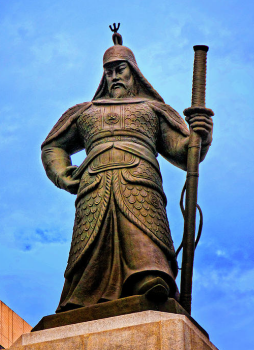
- Before 1967, the Order of the White Star was an award for government employees. It was often listed in Korean government publications as the Order of Civil Merit. In 1967, it was renamed the Order of Service Merit, which should be thought of as the Order of (Civil) Service Merit,
- The 1967 Order of Civil Merit becomes an order of civilian merit.
- The original Order of Service Merit, which had been a non combat award for the military, was renamed the Order of National Security Merit.
- In 1967, the Order of Cultural Merit was absorbed by the (New) Order of Civil Merit. This was done because the government wanted to use the pre-1967 class names for the Order of National Foundation. In 1973, the Order of Cultural Merit was re-established with new Class names and a slightly different focus.
As you go through the various Orders, I will attempt to keep the information readable, but don’t be surprised when you go to a specific order and find me talking about an entirely different order. The Orders, as laid out here on this website, are by their current titles and hierarchy and not listed by what they were originally designed for or by their original legislated priority. For the original Order of National Security, you will need to look at the original Order of Service Merit. For the original Order of Service Merit, you will need to look at the Order of Civil Merit. If you’re like me, you’ve got a headache about this time, but you can imagine how difficult it was to put this information together in the first place.
If you think this short explanation is a pain, try reading the original text. Decorations Law #1885, dated Jan. 16, 1967, states, under Addendum #2: “(Interim Actions) “Prior to the enactment of this act The Order of National Foundation Merit, Jung Jang Class shall be deemed as the 1st class of the Order of National Merit, the Order of National Foundation Merit, Bok Jang Class as the 2nd class of the Order of National Merit, the Order of National Foundation Merit, Tan Jang Class as the 3rd class of the Order of National Merit; the Order of Cultural Merit, Republic of Korea Class as the 1st class of the Order of Civil Merit, the Order of Cultural Merit, President Class as the 2nd class of the Order of Civil Merit, and the Order of Cultural Merit, National Class as the 3rd class of the Order of Civil Merit; the Order of Military Merit, Taeguk Class as the 1st class of the Order of Military Merit, the Order of Military Merit, Ulchi Class as the 2nd class of the Order of Military Merit, the Order of Military Merit, Chungmu Class as the 3rd class of the Order of Military Merit, the Order of Military Merit, Hwarang Class as the 4th class of the Order of Military Merit, and the Order of Military Merit, Inhun Class as the 5th class of the Order of Military Merit; the Order if the White Star, Blue Stripes Class as the 1st class of the Order of Service Merit, the Order of the White Star, Yellow Stripes Class as the 2nd class of the Order of Service Merit, the Order of the White Star, Red Stripes Class as the 3rd class of the Order of Service Merit, the Order of the White Star, Green Stripes Class as the 4th class of the Order of Service Merit, and the Order of the White Star, Aqua Stripes Class as the 5th class of the Order of Service Merit; the Order of Service Merit, 1st Class as the 1st class of the Order of National Security Merit, the Order of Service Merit, 2nd Class as the 2nd class of the Order of National Security Merit, the Order of Service Merit, 3rd Class as the 3rd class of the Order of National Security Merit, the Order of Service Merit, 4th Class as the 4th class of the Order of National Security Merit, and the Order of Service Merit, 5th Class as the 5th class of the Order of National Security Merit; the Order of Diplomatic Service Merit, 1st Class as the 1st class of the Order of Diplomatic Service Merit, the Order of Diplomatic Service Merit, 2nd Class as the 2nd class of the Order of Diplomatic Service Merit, the Order of Diplomatic Service Merit, 3rd Class as the 3rd class of the Order of Diplomatic Service Merit, the Order of Diplomatic Service Merit, 4th Class as the 4th class of the Order of Diplomatic Service Merit, and the Order of Diplomatic Service Merit, 5th Class as the 5th class of the Order of Diplomatic Service Merit; and the Order of Industrial Service Merit, Gold Tower Class as the 1st class of the Order of Industrial Service Merit, the Order of Industrial Service Merit, Silver Tower Class as the 2nd class of the Order of Industrial Service Merit, and the Order of Industrial Service Merit Bronze Tower Class as the 3rd class of the Order of Industrial Service Merit.”
There was another interesting aspect to the 1967 legislation. Smaller sized Orders were authorized for awarding women. The smaller size was only a reflection of the women’s physical stature, and not the importance of their achievements. This was done for the 1st Class on all 11 Orders that were in use at the time of the legislation. In addition to the 1st Class Orders, smaller sizes were created for 2nd Class awards of the Order of National Foundation Merit and the Order of Diplomatic Service Merit. When the Order of Science and Technology was created in 2001, it also had a women’s size for the 1st Class. Interestingly enough, the Order of Science and Technology plays an important role in the demise of the “Women’s Sized” decorations. The differences in the size and thickness of the pendants and breast stars designed for men ranged from approx. 10% to 50% greater than those for women, and the weight was approx. twice that of the women’s awards. On Feb. 28, 1967, when the Awards and Decorations Enforcement Decree was enacted, this size discrimination caused little in the way of repercussions. This all changed on Apr. 21, 2015, during the celebrations of Science Day and Information & Communications Day Celebrations (과학의 날과 정보통신의 날 기념행사). The size difference was very noticeable when comparing the Order of Science and Technology that was presented to former Environment Minister Kim Myung-ja 김명자 (金明子) and the same class of the order that was presented to the two male laureates. Many thought that she had received a lower class of the award. The government made the assertion that the size of the award was a “natural” consequence of women having generally smaller physiques. This did not sit well with many Koreans and on Jan. 1, 2016, under Presidential Decree #26838, the separate sizes for women were abolished.
The Merit and Discipline Act stipulates that an award may be revoked if: 1) the achievement is found to be false, 2) the person is sentenced for a crime related to national security, or 3) he/she is sentenced to imprisonment for more than one year. According to the Ministry of Public Administration and Security, as of May 28, 2020, a total of 707 cases resulted in the cancellation of awarded medals and orders. Of these, 630 cases were canceled according to the Merit and Discipline Act, and 77 cases were canceled according to the ‘Special Act on the May 18 Democratization Movement’, etc. Two former presidents of the Republic of Korea, Chun Doo-hwan (전두환) and Roh Tae-woo (노태우), were stripped of all their Orders and Medals in 2006, but were allowed to keep their Grand Orders of Mugunghwa. To date, neither former president has physically returned any medals. Many Koreans feel that Article 8 of the Distinguished Service Act (Cancellation of Medals) is not properly observed.
Currently, the Republic of Korea has 12 Order of Merit.
For more information on a specific Order, please click on one of the links below:
- THE GRAND ORDER OF MUGUNGHWA 무궁화대훈장
- THE ORDER OF NATIONAL FOUNDATION 건국훈장
- THE ORDER OF CIVIL MERIT 국민훈장
- THE ORDER OF MILITARY MERIT 무공훈장
- THE ORDER OF SERVICE MERIT 근정훈장
- THE ORDER OF NATIONAL SECURITY MERIT 보국훈장
- THE ORDER OF DIPLOMATIC SERVICE MERIT 수교훈장
- THE ORDER OF INDUSTRIAL SERVICE MERIT 산업훈장
- THE ORDER OF SAEMAEUL SERVICE MERIT 새마을훈장
- THE ORDER OF CULTURAL MERIT 문화훈장
- THE ORDER OF SPORTS MERIT 체욕훈장
- THE ORDER OF SCIENCE AND TECHNOLOGY MERIT 과학기술훈장
Currently, issued Orders of Merit (Pictures obtained from the Korean Government Website.)
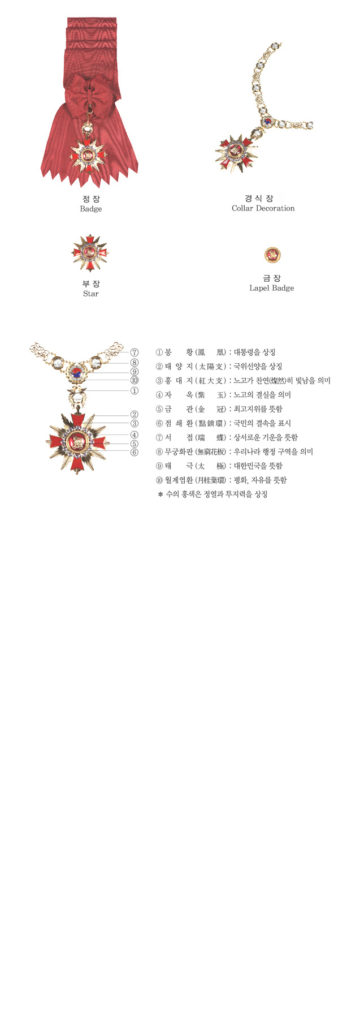
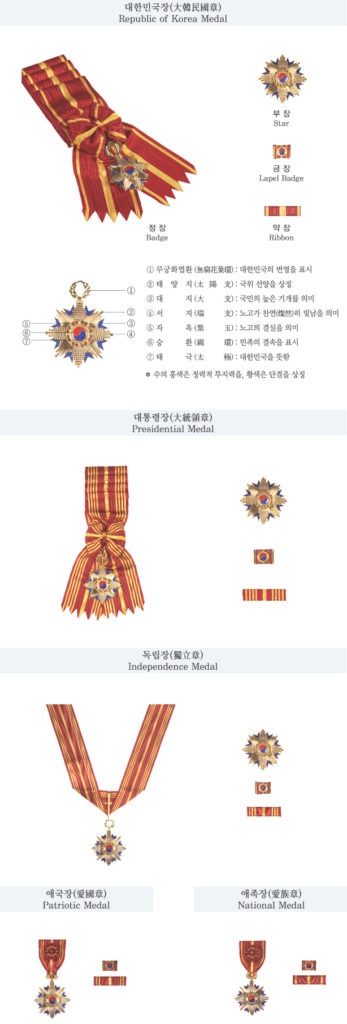
1등급 : 대한민국장(大韓民國章, Republic of Korea Medal)
2등급 : 대통령장(大統領章, Presidential Medal)
3등급 : 독립장(獨立章, Independence Medal)
4등급 : 애국장(愛國章, Patriotic Medal)
5등급 : 애족장(愛族章, National Medal)
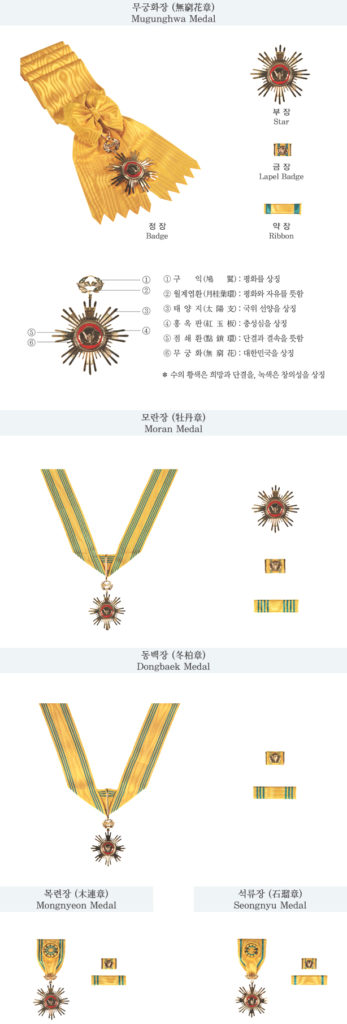
1등급 : 무궁화장(無窮花章, Mugunghwa Medal)
2등급 : 모란장(牡丹章, Moran Medal)
3등급 : 동백장(冬柏章, Dongbaek Medal)
4등급 : 목련장(木蓮章, Mongnyeon Medal)
5등급 : 석류장(石榴章, Seongnyu Medal)
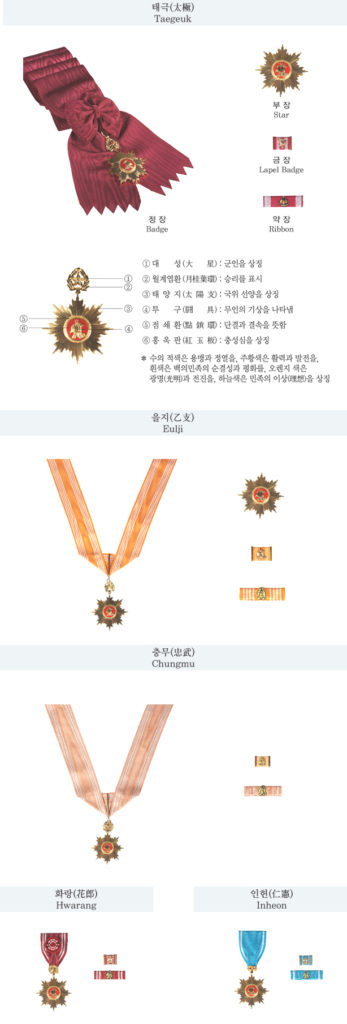
1등급 : 태극(太極, Taegeuk)
2등급 : 을지(乙支, Eulji)
3등급 : 충무(忠武, Chungmu)
4등급 : 화랑(花郞, Hwarang)
5등급 : 인헌(仁憲, Inheon)
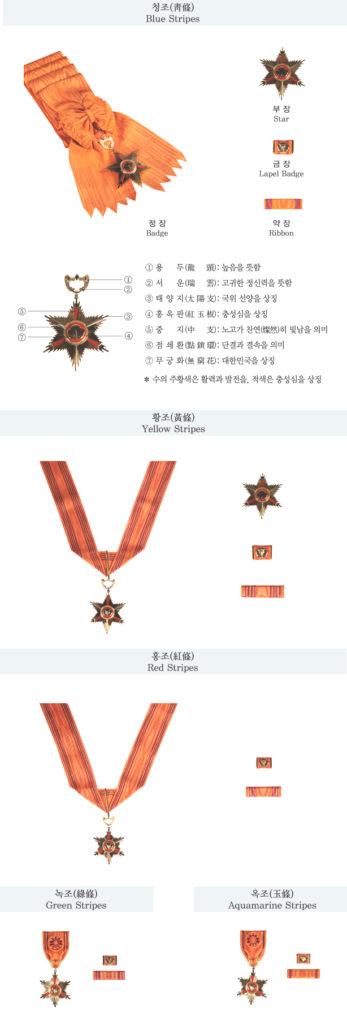
1등급 : 청조(靑條, Blue Stripes)
2등급 : 황조(黃條, Yellow Stripes)
3등급 : 홍조(紅條, Red Stripes)
4등급 : 녹조(綠條, Green Stripes)
5등급 : 옥조(玉條, Aquamarine Stripes)
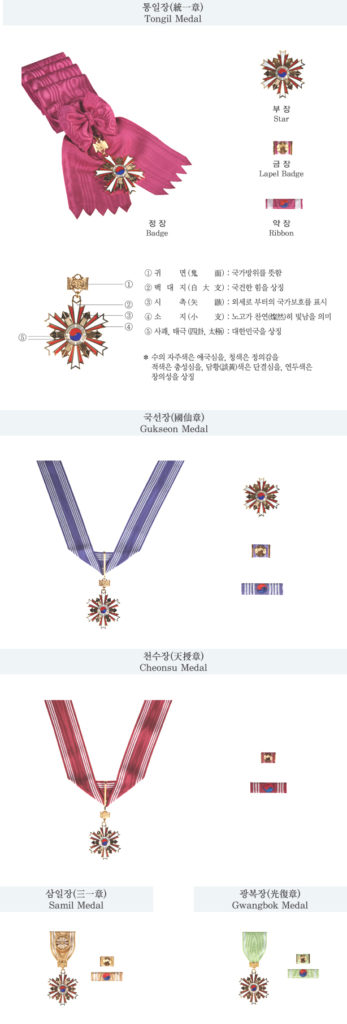
1등급 : 통일장(統一章, Tongil Medal)
2등급 : 국선장(國仙章, Gukseon Medal)
3등급 : 천수장(天授章, Cheonsu Medal)
4등급 : 삼일장(三一章, Samil Medal)
5등급 : 광복장(光復章, Gwangbok Medal)

1등급 : 광화대장(光化大章, Grand Gwanghwa Medal),광화장(光化章, Gwanghwa Medal)
2등급 : 흥인장(興仁章, Heungin Medal)
3등급 : 숭례장(崇禮章, Sungnye Medal)
4등급 : 창의장(彰義章, Changui Medal)
5등급 : 숙정장(肅靖章, Sukjeong Medal)
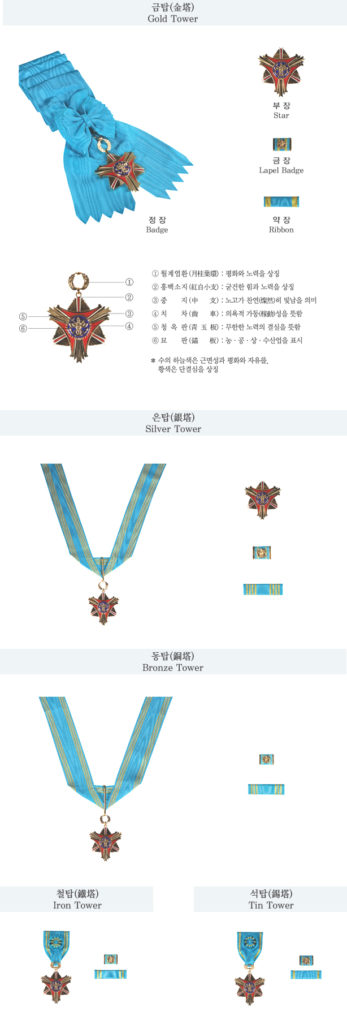
1등급 : 금탑(金塔, Gold Tower)
2등급 : 은탑(銀塔, Silver Tower)
3등급 : 동탑(銅塔, Bronze Tower)
4등급 : 철탑(鐵塔, Iron Tower)
5등급 : 석탑(錫塔, Tin Tower)
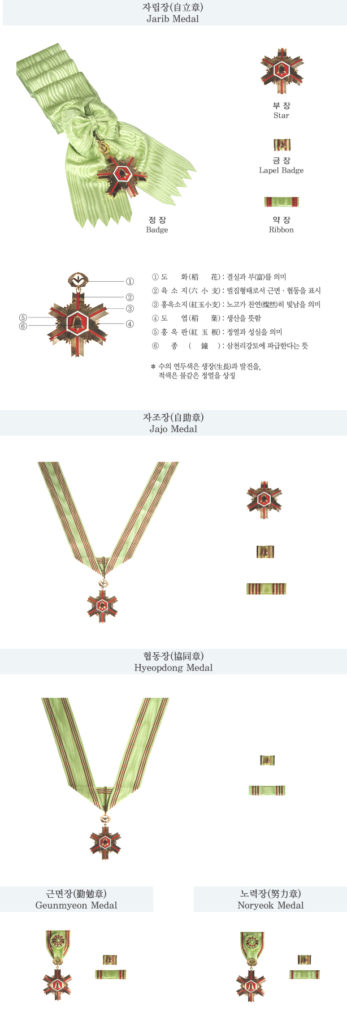
1등급 : 자립장(自立章, Jarib Medal)
2등급 : 자조장(自助章, Jajo Medal)
3등급 : 협동장(協同章, Hyeopdong Medal)
4등급 : 근면장(勤勉章, Geunmyeon Medal)
5등급 : 노력장(努力章, Noryeok Medal)
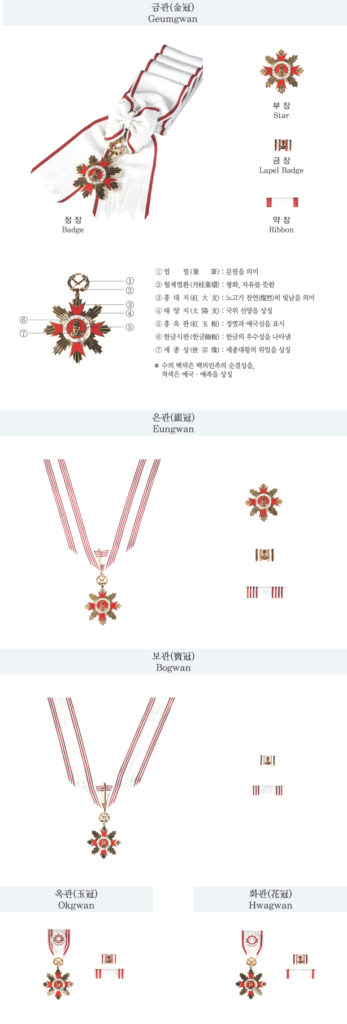
1등급 : 금관(金冠, Geumgwan)
2등급 : 은관(銀冠, Eungwan)
3등급 : 보관(寶冠 Bogwan)
4등급 : 옥관(玉冠 Okgwan)
5등급 : 화관(花冠 Hwagwan)
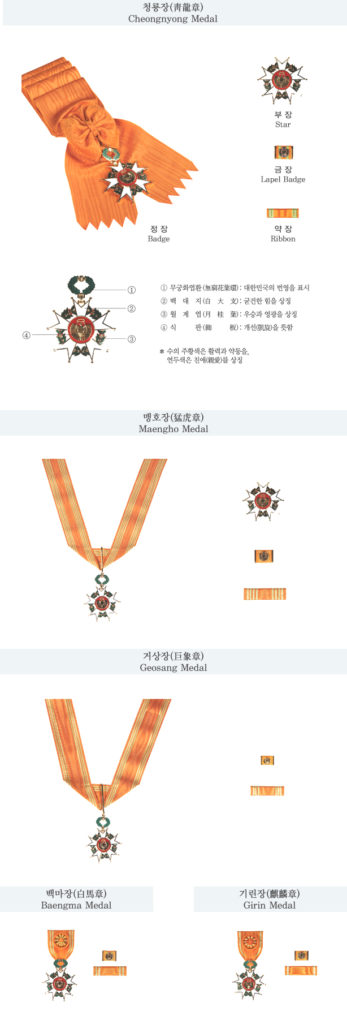
1등급 : 청룡장(靑龍章, Cheongnyong Medal)
2등급 : 맹호장(猛虎章, Maengho Medal)
3등급 : 거상장(巨象章, Geosang Medal)
4등급 : 백마장(白馬章, Baengma Medal)
5등급 : 기린장(麒麟章, Girin Medal)
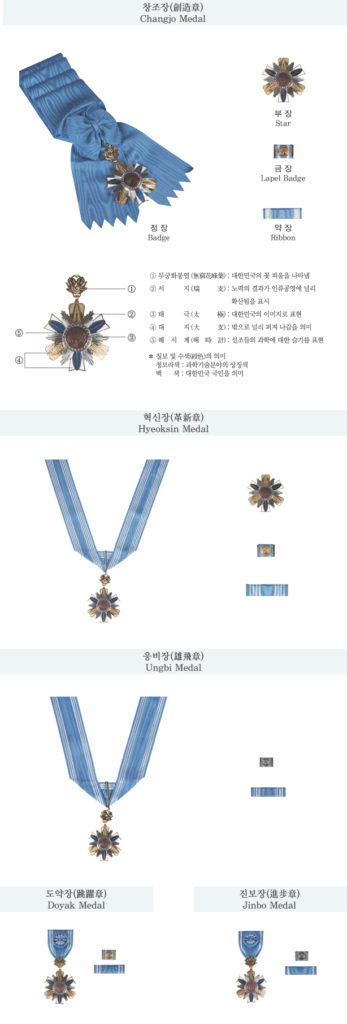
1등급 : 창조장(創造章, Changjo Medal)
2등급 : 혁신장(革新章, Hyeoksin Medal)
3등급 : 웅비장(雄飛章, Ungbi Medal)
4등급 : 도약장(跳躍章, Doyak Medal)
5등급 : 진보장(進步章, Jinbo Medal)
